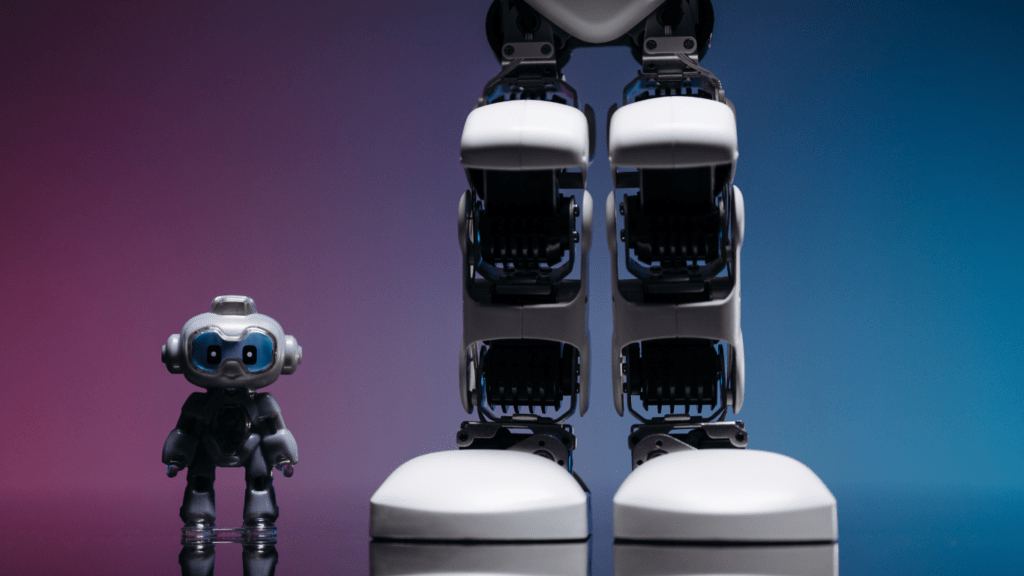The Intersection of Robotics and Art
Robotics and art converge to create a realm where precision meets creativity. This intersection opens new possibilities for artists and technologists alike.
What Is Robotic Art?
Robotic art integrates autonomous machines into the creative process. These robots create artworks based on programmed algorithms or artificial intelligence.
Artists like Patrick Tresset and Sougwen Chung exemplify this fusion by using robots as creative partners. Tresset’s robots draw portraits, mimicking human style. Chung combines robotics with traditional painting, guiding robotic arms to enhance her artwork.
Historical Background of Robotics in Art
Robotics in art trace its roots to the 1960s. Nam June Paik, a Korean artist, was among the first to use robots in his installations. In the 1980s, Harold Cohen developed AARON, an AI-driven robot capable of creating original drawings.
By the 21st century, advancements in AI and robotics technology expanded, leading to more sophisticated and varied applications of robots in art. Robots began painting, sculpting, and even performing alongside human artists, pushing the boundaries of artistic expression.
Robotic art continues to evolve, challenging traditional viewpoints and blending technology and creativity in unprecedented ways.
Technological Advancements in Robotic Art
Robotic art evolves rapidly due to technological advancements. Cutting-edge materials and innovative techniques enable artists to push boundaries.
Innovative Materials and Techniques
Innovative materials and techniques transform robotic art. Advanced sensors, lightweight metals, and 3D printing allow for unparalleled precision and complexity.
For instance, artists employ titanium and carbon fiber to create durable and intricate sculptures. Machine learning algorithms generate unique patterns and designs, enhancing creativity.
3D printing revolutionizes sculpture-making. Artists design complex structures with digital software, then print them layer by layer.
Autonomous drones, equipped with paint or sculpting tools, create large-scale installations previously impossible by human hands. Soft robotics, mimicking organic movements, add fluidity and life to artworks, creating dynamic pieces that engage audiences.
Advanced sensors enhance interactivity. Pressure-sensitive materials and motion detectors let artworks respond to viewer movements. This real-time feedback bridges the gap between spectator and creation, making art an immersive experience.
Case Studies of Notable Robotic Artworks

Several notable artworks exemplify the impact of robotics in art. Patrick Tresset’s robots, such as “Paul,” draw lifelike portraits. Tresset programs robots to mimic human drawing techniques, showcasing a blend of precision and artistic interpretation. These robotic artists produce works that intrigue both art enthusiasts and tech aficionados.
Sougwen Chung’s collaborative pieces with robots, like “Drawing Operations,” merge traditional painting with robotic precision. Chung’s robots, trained to mimic her style, create intricate patterns in real-time as she paints alongside them. The result is a harmonious blend of human creativity and robotic accuracy.
Harold Cohen’s “AARON,” one of the earliest robotic artists, generates complex abstract paintings. Cohen developed algorithms that enable “AARON” to create without human intervention, paving the way for autonomous artistic robots.
These examples illustrate the transformative power of robotics in art. By integrating advanced materials, innovative techniques, and AI, artists unlock new realms of creativity, offering fresh perspectives on art’s potential.
The Creative Process in Robotic Art
Exploring the intersection of technology and creativity, the process of creating robotic art involves several intricate steps. From initial concepts to final designs, each phase integrates human ingenuity with robotic precision.
From Conceptualization to Design
The creative journey in robotic art begins with conceptualization. Artists, like:
- painters
- sculptors
envision what they want to express. They sketch initial ideas, often using digital tools for more precise drafts. These early stages focus on merging human artistic intent with robotic capabilities.
After conceptualizing, artists move to design. CAD software and other digital platforms help in creating detailed models, ensuring every aspect is technically feasible for robotic execution.
The design phase requires aligning the art’s aesthetic goals with the robot’s programming and mechanical abilities. The use of 3D modeling allows for simulations, ensuring the final creation mirrors the artist’s vision.
The Role of AI in Artistic Creation
AI plays a pivotal role in the artistic creation process. Advanced algorithms assist robots in understanding and replicating artistic styles. For instance, machine learning models analyze vast datasets of artistic works, enabling robots to mimic specific techniques or create new interpretations.
AI doesn’t just enhance precision; it introduces randomness and spontaneity, vital for creative expression. Robots, guided by AI, can analyze and learn from real-time feedback, adjusting strokes and movements to achieve desired outcomes.
This symbiotic relationship between artificial intelligence and human oversight pushes the boundaries of what robotic art can achieve.
In essence, the integration of AI ensures that robotic art is not just a mechanical reproduction but an evolving collaboration between technology and human creativity.
Main Benefits and Challenges
Robotics in art offers significant benefits but also presents unique challenges. Let’s explore both aspects in detail.
Enhancing Artistic Expression
Robots enhance artistic expression by enabling artists to experiment with new techniques and mediums. With robotic assistance, artists can create more intricate and precise designs than human hands alone.
For example, robotic arms use algorithms to replicate complex brushstrokes, resulting in unique, high-precision artworks. These advancements allow artists to push creative boundaries, incorporating elements like generative design and kinetic art.
AI-driven robots also facilitate collaboration by interpreting artistic styles. Artists program robots with specific parameters, guiding them in replicating certain aesthetic qualities.
This symbiotic relationship expands the artist’s toolkit, providing an endless array of possibilities for innovation and creativity. The incorporation of robotics into art democratizes artistic creation, as artists with limited physical abilities can leverage robots to manifest their artistic visions.
Addressing Technical Complexities
Integrating robotics into art presents technical complexities that must be addressed. Artists need to familiarize themselves with programming languages and robotic systems.
This technical learning curve can initially be a barrier to entry. Technical difficulties, like maintaining precision and ensuring robots execute tasks consistently, require ongoing troubleshooting and adjustments.
Robotics in art also raises questions of authorship and originality. It’s essential to determine how much credit goes to the human artist versus the robot.
Legal and ethical considerations, such as intellectual property rights, need careful examination. This balancing act, between leveraging technology and maintaining artistic authenticity, is an ongoing challenge for artists and technologists alike.
Overall, embracing robotics in art offers transformative opportunities but necessitates addressing technical, ethical, and intellectual complexities to fully harness its potential.
Future Outlook of Robotics in Art
Robotics is set to revolutionize the art world in the coming years. Technologies continue to advance rapidly, and artists increasingly explore robotics for creative expression.
Emerging Trends
Several trends indicate where robotics in art is headed. One notable trend involves interactive and responsive installations. Artists use sensors and AI algorithms to create artworks that react to viewers’ movements or emotions.
For example, audience interactions could influence the colors of a light installation or the drawings produced by a robotic arm.
Another trend is the collaboration between human artists and robots. Instead of robots merely replicating human works, artists program robots to contribute uniquely to the creative process.
This can be seen in performances where robots improvise alongside human musicians, creating a blend of human and machine artistry.
Additionally, robots are beginning to take on roles beyond traditional art-making. They curate, critique, and even auction art pieces. For example, AI programs analyze art portfolios to suggest curatorial decisions for exhibitions, representing a shift toward AI-driven art distribution.
Potential Impact on the Art World
The integration of robotics into art promises significant impacts.
- First, it democratizes art creation. Previously inaccessible techniques and mediums are now available to a broader range of artists. Artists without formal training can experiment with complex media by leveraging robotic tools.
- Robotics also challenges traditional notions of authorship and originality. If an artwork results from both human and machine input, questions arise about who owns the creative rights. These discussions could lead to new legal frameworks in copyright law.
- Robots contribute to the preservation and restoration of artworks. Using machine learning algorithms, they can restore damaged pieces with high precision, ensuring the longevity of cultural heritage.
- Finally, robotics expands the boundaries of what we define as art. With robots producing unpredictable and novel works, the definition of creativity and artistic expression evolves.
- This evolution could lead to entirely new art forms, blending technology and traditional craftsmanship in unprecedented ways.

 Anna Freehill, a key contributor to Avant Garde Artistry Hub, plays a vital role in shaping the platform’s vision. As an author and collaborator, she helps bridge the worlds of art and technology, offering insightful articles that guide artists through the rapidly evolving creative landscape. Anna’s dedication to highlighting art's therapeutic value has contributed to the platform’s focus on mental and emotional well-being through creative expression.
Her involvement in building Avant Garde Artistry Hub has been instrumental in providing valuable resources to artists seeking to enhance their careers. Whether through her writing on business strategies or her support in platform development, Anna is committed to fostering a space where artists can thrive and embrace the future of art.
Anna Freehill, a key contributor to Avant Garde Artistry Hub, plays a vital role in shaping the platform’s vision. As an author and collaborator, she helps bridge the worlds of art and technology, offering insightful articles that guide artists through the rapidly evolving creative landscape. Anna’s dedication to highlighting art's therapeutic value has contributed to the platform’s focus on mental and emotional well-being through creative expression.
Her involvement in building Avant Garde Artistry Hub has been instrumental in providing valuable resources to artists seeking to enhance their careers. Whether through her writing on business strategies or her support in platform development, Anna is committed to fostering a space where artists can thrive and embrace the future of art.